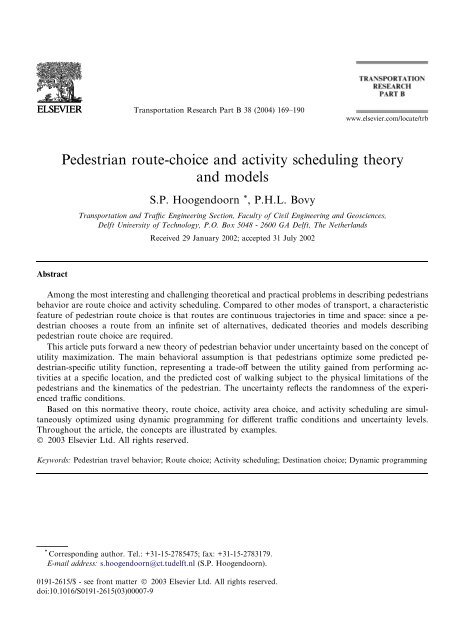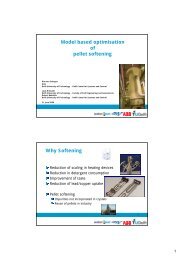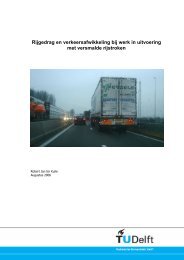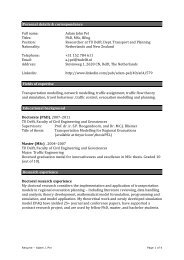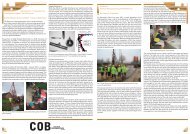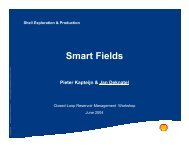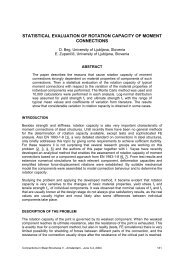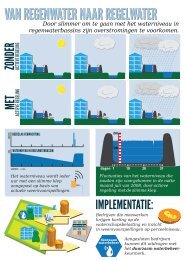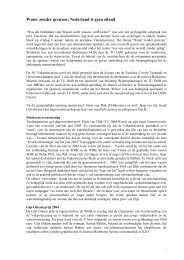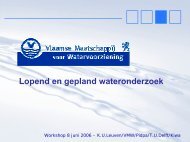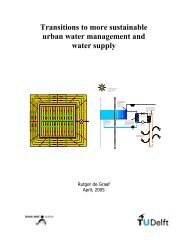Pedestrian route-choice and activity scheduling theory and models
Pedestrian route-choice and activity scheduling theory and models
Pedestrian route-choice and activity scheduling theory and models
Create successful ePaper yourself
Turn your PDF publications into a flip-book with our unique Google optimized e-Paper software.
Transportation Research Part B 38 (2004) 169–190<br />
www.elsevier.com/locate/trb<br />
<strong>Pedestrian</strong> <strong>route</strong>-<strong>choice</strong> <strong>and</strong> <strong>activity</strong> <strong>scheduling</strong> <strong>theory</strong><br />
<strong>and</strong> <strong>models</strong><br />
S.P. Hoogendoorn * , P.H.L. Bovy<br />
Transportation <strong>and</strong> Traffic Engineering Section, Faculty of Civil Engineering <strong>and</strong> Geosciences,<br />
Delft University of Technology, P.O. Box 5048 - 2600 GA Delft, The Netherl<strong>and</strong>s<br />
Received 29 January 2002; accepted 31 July 2002<br />
Abstract<br />
Among the most interesting <strong>and</strong> challenging theoretical <strong>and</strong> practical problems in describing pedestrians<br />
behavior are <strong>route</strong> <strong>choice</strong> <strong>and</strong> <strong>activity</strong> <strong>scheduling</strong>. Compared to other modes of transport, a characteristic<br />
feature of pedestrian <strong>route</strong> <strong>choice</strong> is that <strong>route</strong>s are continuous trajectories in time <strong>and</strong> space: since a pedestrian<br />
chooses a <strong>route</strong> from an infinite set of alternatives, dedicated theories <strong>and</strong> <strong>models</strong> describing<br />
pedestrian <strong>route</strong> <strong>choice</strong> are required.<br />
This article puts forward a new <strong>theory</strong> of pedestrian behavior under uncertainty based on the concept of<br />
utility maximization. The main behavioral assumption is that pedestrians optimize some predicted pedestrian-specific<br />
utility function, representing a trade-off between the utility gained from performing activities<br />
at a specific location, <strong>and</strong> the predicted cost of walking subject to the physical limitations of the<br />
pedestrians <strong>and</strong> the kinematics of the pedestrian. The uncertainty reflects the r<strong>and</strong>omness of the experienced<br />
traffic conditions.<br />
Based on this normative <strong>theory</strong>, <strong>route</strong> <strong>choice</strong>, <strong>activity</strong> area <strong>choice</strong>, <strong>and</strong> <strong>activity</strong> <strong>scheduling</strong> are simultaneously<br />
optimized using dynamic programming for different traffic conditions <strong>and</strong> uncertainty levels.<br />
Throughout the article, the concepts are illustrated by examples.<br />
Ó 2003 Elsevier Ltd. All rights reserved.<br />
Keywords: <strong>Pedestrian</strong> travel behavior; Route <strong>choice</strong>; Activity <strong>scheduling</strong>; Destination <strong>choice</strong>; Dynamic programming<br />
* Corresponding author. Tel.: +31-15-2785475; fax: +31-15-2783179.<br />
E-mail address: s.hoogendoorn@ct.tudelft.nl (S.P. Hoogendoorn).<br />
0191-2615/$ - see front matter Ó 2003 Elsevier Ltd. All rights reserved.<br />
doi:10.1016/S0191-2615(03)00007-9
170 S.P. Hoogendoorn, P.H.L. Bovy / Transportation Research Part B 38 (2004) 169–190<br />
1. Background<br />
Underst<strong>and</strong>ing pedestrian behavior is essential in the planning <strong>and</strong> the design of airports,<br />
public transport stations, shopping malls, etc., but also in public transit timetable design. Modeling<br />
tools can support infrastructure designers as well as public transport planners to optimize<br />
their plans. Furthermore, the management of pedestrian flows dem<strong>and</strong>s underst<strong>and</strong>ing of both the<br />
collective pedestrian flows as well as the individual pedestrian movements in the flow.<br />
<strong>Pedestrian</strong> traffic <strong>and</strong> vehicular traffic are very different, justifying dedicated <strong>theory</strong> <strong>and</strong> model<br />
development. The differences pertain both to traffic operations, <strong>and</strong> to the travel behavior level.<br />
Motivated by the need for accurate dedicated pedestrian flow <strong>models</strong>, comprehensive <strong>theory</strong> <strong>and</strong><br />
<strong>models</strong> for pedestrian <strong>activity</strong> <strong>scheduling</strong>, <strong>route</strong> determination in the two-dimensional space, <strong>and</strong><br />
walking behavior have been developed. This paper focuses on the behavior at the tactical level.<br />
The walking behavior is discussed elsewhere (Hoogendoorn, 2001).<br />
The article is outlined as follows. Section 2 discusses some empirical facts about pedestrian<br />
<strong>activity</strong> <strong>scheduling</strong> <strong>and</strong> <strong>route</strong> <strong>choice</strong>. Section 3 recalls previous theories <strong>and</strong> <strong>models</strong> describing<br />
pedestrian <strong>route</strong> <strong>choice</strong> behavior. Section 4 outlines the normative <strong>theory</strong>. Sections 5 <strong>and</strong> 6 respectively<br />
present the <strong>route</strong> <strong>choice</strong> <strong>and</strong> <strong>activity</strong> <strong>scheduling</strong> modeling approach. We recall the<br />
walker model from (Hoogendoorn, 2001) in Section 7. Model applications are described in Section<br />
8. Section 9 summarizes the research results <strong>and</strong> discusses future research directions.<br />
2. Empirical facts on pedestrian <strong>scheduling</strong> <strong>and</strong> <strong>route</strong> <strong>choice</strong><br />
In this article, pedestrian <strong>activity</strong> <strong>scheduling</strong> pertains to which, in which order, <strong>and</strong> where pedestrians<br />
perform activities. <strong>Pedestrian</strong> <strong>activity</strong> <strong>scheduling</strong> has not been studied comprehensively<br />
in the past. There are some indications that pedestrians somehow optimize the order in which they<br />
perform their activities, <strong>and</strong> that directness plays an important role (Helbing, 1997).<br />
Hill (1982) has analyzed pedestrian strategies for choosing <strong>and</strong> describing <strong>route</strong>s. He concludes<br />
that, like most walking processes, <strong>route</strong> selection strategies are largely subconscious. Furthermore,<br />
directness is the most common reason for choosing a particular <strong>route</strong>. The <strong>route</strong> directness<br />
pertains not only to the length of the <strong>route</strong>, but also to its complexity (in terms of direction<br />
changes). <strong>Pedestrian</strong>s appear to frequently choose the shortest <strong>route</strong>, albeit they are seldom aware<br />
that they are minimizing distance as a primary strategy in <strong>route</strong> <strong>choice</strong> (Senevarante <strong>and</strong> Morall,<br />
1986; Guy, 1987). Other studies indicate that besides distance, pleasantness is an important <strong>route</strong><br />
attribute together producing a high correlation with the <strong>route</strong> preferences (Bovy <strong>and</strong> Stern, 1990).<br />
Other factors deemed important in <strong>route</strong> <strong>choice</strong> behavior are habit, number of crossings,<br />
pollution <strong>and</strong> noise levels, safety <strong>and</strong> shelter from poor weather conditions, <strong>and</strong> stimulation of the<br />
environment. The extent to which these <strong>route</strong> attributes play a substantial role his <strong>route</strong> <strong>choice</strong><br />
behavior depends to a large extent on trip purpose (Bovy <strong>and</strong> Stern, 1990), e.g. scenery is very<br />
important for recreational trips, but it plays no role for work-related walking trips.<br />
Cheung <strong>and</strong> Lam (1998) study pedestrians choosing between escalators <strong>and</strong> stairways in subway<br />
stations <strong>and</strong> its dependency on the differences in travel times. The authors showed that pedestrians<br />
are more susceptible to delays in the descending direction than in the ascending<br />
direction, <strong>and</strong> are more inclined to use the escalator in the latter case.
S.P. Hoogendoorn, P.H.L. Bovy / Transportation Research Part B 38 (2004) 169–190 171<br />
3. Modeling approaches to pedestrian travel behavior<br />
Queuing <strong>models</strong> (Lovas, 1994) use Markov-chain <strong>models</strong> to described how pedestrians move<br />
from one node of the network (mostly a room) to another. R<strong>and</strong>om waiting times are incurred on<br />
the links, due to queues building up when pedestrian traffic dem<strong>and</strong> is larger than the door capacity.<br />
Queuing <strong>models</strong> have been used mostly to describe pedestrian evacuation behavior from<br />
buildings.<br />
Gipps (1986) <strong>and</strong> Hamacher <strong>and</strong> Tj<strong>and</strong>ra (2001) describe pedestrian <strong>route</strong> <strong>choice</strong> through the<br />
walking facility by determining a finite number of <strong>route</strong>s through the walking infrastructure <strong>and</strong><br />
applying basic discrete <strong>choice</strong> modeling. Similar to the model described in this article, the main<br />
theoretical assumption is that pedestrians make a subjective rational <strong>choice</strong> between alternatives.<br />
Contrary to the model described in this article, the number of <strong>choice</strong> options is finite. Verl<strong>and</strong>er<br />
(1997) estimates discrete <strong>choice</strong> <strong>models</strong> using household-based diary data. Teklenburg et al. (1993)<br />
use a Space Syntax model, which is calibrated using pedestrian flow data.<br />
Notwithst<strong>and</strong>ing the practicality of assuming only a limited number of <strong>route</strong> alternatives, in<br />
real life pedestrians can choose between an infinite (<strong>and</strong> in fact, non-countable) number of <strong>route</strong>s.<br />
Using potential functions, Hughes (2002) accounts for this aspect, by describing the optimal<br />
walking direction to the destination (in terms of travel time) as a function of the current location x<br />
of the pedestrian. However, the approach prohibits including general <strong>route</strong> attributes, such as<br />
walking distance or stimulation of the environment, as well as uncertainty in the traffic conditions<br />
expected by the pedestrians. The research described in this article has succeeded in remedying<br />
these issues, while at the same time establishing a solid theoretical basis for pedestrian <strong>route</strong><strong>choice</strong><br />
<strong>and</strong> <strong>activity</strong> <strong>scheduling</strong>.<br />
4. Normative pedestrian behavior <strong>theory</strong><br />
The main behavioral assumption here, is that all actions of the pedestrian, let it be performing<br />
an <strong>activity</strong> or walking along a certain <strong>route</strong>, will provide utility (or equivalently, induce cost) to<br />
him. The pedestrian will predict <strong>and</strong> optimize this expected utility, taking into account the uncertainty<br />
in the expected traffic conditions (similar to microeconomic consumer <strong>theory</strong>). It is well<br />
known that normative <strong>choice</strong> <strong>theory</strong> will not fully cover real-life human <strong>choice</strong> behavior. It does<br />
however provide a very convenient framework for modeling human decision making (Van Berkum<br />
<strong>and</strong> Van Der Mede, 1993). Moreover, several empirical studies have shown the applicability<br />
of utility-based approaches to pedestrian <strong>route</strong> <strong>choice</strong> (Hill, 1982; Bovy <strong>and</strong> Stern, 1990). Hence,<br />
its use in pedestrian behavior <strong>theory</strong> is justified.<br />
The <strong>theory</strong> presented here differs from discrete <strong>choice</strong> <strong>theory</strong> in a number of ways. First <strong>and</strong><br />
foremost, an infinite number of alternative <strong>route</strong>s is considered. Secondly, the r<strong>and</strong>omness in the<br />
<strong>theory</strong> pertains to the uncertainty in the <strong>route</strong> that can be realised. In stochastic discrete <strong>choice</strong><br />
<strong>theory</strong>, the r<strong>and</strong>omness reflects both the fact that people do not always make the same decisions<br />
under the same circumstances <strong>and</strong> the analystÕs lack of more precise knowledge about individualsÕ<br />
decision processes. Furthermore, discrete <strong>choice</strong> <strong>models</strong> are often used to describe the differences<br />
in observed <strong>choice</strong>s made in a sample of individuals. The <strong>theory</strong> presented here is designed to<br />
describe <strong>choice</strong> behavior of individuals, <strong>and</strong> is there not directly representative for groups of
172 S.P. Hoogendoorn, P.H.L. Bovy / Transportation Research Part B 38 (2004) 169–190<br />
individuals. Nevertheless, the continuous <strong>theory</strong> is easily extended to include for instance taste<br />
variation.<br />
4.1. <strong>Pedestrian</strong> behavioral levels<br />
In out approach we distinguish <strong>choice</strong>s at the following three levels:<br />
1. Departure time <strong>choice</strong>, <strong>and</strong> <strong>activity</strong> pattern <strong>choice</strong> (strategic level);<br />
2. Activity <strong>scheduling</strong>, <strong>activity</strong> area <strong>choice</strong>, <strong>and</strong> <strong>route</strong>-<strong>choice</strong> to reach <strong>activity</strong> areas (tactical level);<br />
3. Walking behavior (operational level).<br />
In this hierarchy, expected utilities at lower levels influence <strong>choice</strong>s at higher levels. Choices at<br />
higher levels condition <strong>choice</strong> sets at lower levels. This article focuses on pedestrian behavior at<br />
the tactical level. The events <strong>and</strong> decisions causing the pedestrian to arrive at the walking facility<br />
are not considered; pedestrian arrival patterns, distinguishing groups of pedestrians having similar<br />
characteristics (<strong>activity</strong> sets, travel purpose, demographic characteristics, etc.) are assumed known<br />
a priori. With respect to the operational level, it is hypothesized that pedestrians adhere to their<br />
planned <strong>route</strong> (determined at the tactical level) as much as possible. In addition, walking is affected<br />
by interactions with other pedestrians or obstacles. For details, we refer to (Hoogendoorn,<br />
2001).<br />
The tactical level behavior is influenced by both external factors (e.g. presence of obstacles,<br />
stimulation of the environment), <strong>and</strong> internal (or personal) factors (e.g. time–pressure, attitudes of<br />
the pedestrian). Together with the expected traffic conditions (congestion, average speeds), the<br />
decisions at the tactical level serve as input for pedestrianÕs walking behavior. In turn, the traffic<br />
conditions resulting from the pedestrian traffic dem<strong>and</strong>s <strong>and</strong> the collective walking behavior will<br />
affect the expected traffic conditions <strong>and</strong> thus the behavior at the tactical level.<br />
4.2. Tactical level decision variables<br />
Before we present the problem formulation, let us introduce the key decision variables for the<br />
pedestrian behavior at the tactical level<br />
1. The <strong>activity</strong> schedule S ¼fig, which is an ordered set describing which activities i 2 R are performed<br />
<strong>and</strong> in which order.<br />
2. The velocity trajectory vðÞ yielding the <strong>route</strong> xðÞ through the facility.<br />
3. The <strong>activity</strong> times T i at which activities i 2 S are performed, such that xðT i Þ2A ij for some j,<br />
where A ij denote the <strong>activity</strong> areas where <strong>activity</strong> i can be performed.<br />
A pedestrian arriving at the walking facility X R 2 aims to perform (a type of) activities from<br />
the subjective <strong>activity</strong> <strong>choice</strong> set R, which consists of possible activities to perform in the facility,<br />
e.g. ‘‘buy a newspaper’’, ‘‘buy a train ticket’’, ‘‘wait at the train platform’’, or ‘‘access the train’’.<br />
The activities are generic, <strong>and</strong> reflect the purposes of the pedestrians in the facility.<br />
The pedestrian chooses activities from the subjective <strong>activity</strong> <strong>choice</strong> set R, yielding the <strong>activity</strong><br />
schedule S ¼fig. S describes which activities from R are performed <strong>and</strong> in which order. The
S.P. Hoogendoorn, P.H.L. Bovy / Transportation Research Part B 38 (2004) 169–190 173<br />
pedestrian may have some freedom to choose where <strong>activity</strong> i from S is performed. This is<br />
modeled by considering different <strong>activity</strong> areas A ij X with j ¼ 1; ...; J i , where <strong>activity</strong> i can be<br />
performed. For example, a traveler can ‘‘buy a newspaper’’ at different ticket machines or ticket<br />
offices.<br />
Terminal time T i for <strong>activity</strong> i denotes the instant at which <strong>activity</strong> i is completed. That is, the<br />
difference T i T i 1 equals the expected walking time <strong>and</strong> the time needed to perform <strong>activity</strong> i.<br />
Together with the <strong>route</strong> xðÞ through the facility, the terminal time determines the <strong>activity</strong> area A ij<br />
chosen by the pedestrian, i.e. xðT i Þ2A ij (assuming that the pedestrian will not move while performing<br />
the <strong>activity</strong>). The <strong>route</strong> xðÞ is a continuous function, uniquely determined by the velocity<br />
path vðÞ<br />
xðÞ :¼ fxðsÞ 2Xjt 0 6 s 6 t 1 s:t: _xðsÞ ¼vðsÞ <strong>and</strong> xðt 0 Þ¼x 0 g ð1Þ<br />
4.3. Subjective utility optimization at the tactical level<br />
We hypothesize that at the tactical level, a pedestrian makes a simultaneous decision at time t 0<br />
minimizing the expected disutility or cost C. This decision will cover all decision variables described<br />
in the previous section (<strong>activity</strong> patterns S, terminal times T i , <strong>and</strong> the velocity path vðÞ).<br />
The expected disutility C ¼ CðS; fT i g i2S<br />
; vðÞjt 0 ; x 0 Þ of the combined <strong>choice</strong> of a pedestrian entering<br />
the walking facility at instant t 0 at location x 0 stems from performing specific activities at certain<br />
<strong>activity</strong> areas, the order in which the activities are performed, <strong>and</strong> the expected cost of walking<br />
between the <strong>activity</strong> areas. We assume that the total disutility can be written as follows<br />
CðS; fT i g i2S<br />
; vðÞjt 0 ; x 0 Þ :¼ X i2S<br />
C i ðT i ; vðÞjT i 1 ; xðT i 1 ÞÞ þ wðSÞ ð2Þ<br />
where C i denotes the combined cost of walking from the location xðT i 1 Þ2A i 1j to xðT i Þ2A ij<br />
where <strong>activity</strong> i is performed, <strong>and</strong> the cost (or utility U ij ) of performing <strong>activity</strong> i at <strong>activity</strong> area<br />
A ij ; w denotes the cost of the <strong>activity</strong> <strong>scheduling</strong> (e.g. due to the specific order of activities). In the<br />
remainder, the components C i are specified. Subjective utility optimization then yields that the<br />
pedestrian makes the following combined <strong>choice</strong> at the tactical level<br />
ðS ; fT i g i2S ; v ðÞÞ ¼ arg minCðS; fT i g i2S<br />
; vðÞjt 0 ; x 0 Þ<br />
ð3Þ<br />
Activity i may be performed at multiple <strong>activity</strong> areas A ij , yielding different utilities U ij . These<br />
differences reflect personal preferences for using a certain area (e.g. describing that pedestrians<br />
expect different waiting times at different ticket offices). Some activities are discretionary, others<br />
are m<strong>and</strong>atory, which is described by high penalties / i experienced when <strong>activity</strong> i is not performed.<br />
The order in which activities are performed generally depends on the directness (Helbing,<br />
1997) <strong>and</strong> results from the simultaneous <strong>choice</strong>s made at the tactical level. Directness is reflected<br />
by the cost stemming from the trajectory xðÞ; wðSÞ is generally only used describe that the <strong>activity</strong><br />
order is restricted, implying that some activities can be performed only once others are completed.<br />
Although pedestrian <strong>route</strong> <strong>choice</strong> is mostly subconscious, assuming that <strong>route</strong> <strong>choice</strong> strategies<br />
are applicable to predict pedestrian <strong>choice</strong> behavior is fruitful from a modeling viewpoint (Hill,<br />
1982). We therefore assume that the pedestrian <strong>route</strong> <strong>choice</strong> is based on utility optimization. The<br />
disutility C i of a <strong>route</strong> will depend among other things on (Chiolek, 1978; Gipps, 1986):
174 S.P. Hoogendoorn, P.H.L. Bovy / Transportation Research Part B 38 (2004) 169–190<br />
1. Distance or travel time between origin <strong>and</strong> destination.<br />
2. Proximity of obstacles or other physical obstructions; closeness to walls.<br />
3. Number of sharp turns <strong>and</strong> rapid directional changes (<strong>route</strong> directness).<br />
4. Expected number of interactions with other pedestrians (level-of-service).<br />
5. Stimulation of environment, <strong>and</strong> attractiveness (e.g. ambience conditions, shopping windows,<br />
shelter in case of poor weather conditions).<br />
Empirical studies (Bovy <strong>and</strong> Stern, 1990; Guy, 1987; Senevarante <strong>and</strong> Morall, 1986) have<br />
shown that these factors are not mutually consistent, while their importance in <strong>route</strong> <strong>choice</strong> will<br />
vary between different (homogeneous) groups of pedestrians.<br />
4.4. Prevailing traffic conditions <strong>and</strong> dynamic pedestrian assignment<br />
One important aspect in pedestrian <strong>activity</strong> <strong>scheduling</strong> <strong>and</strong> <strong>route</strong> <strong>choice</strong> is the inclusion of<br />
prevailing or future traffic conditions into the decision-making at the tactical level. We assume<br />
that pedestrians have information (visual information, experience) regarding prevailing <strong>and</strong> future<br />
conditions <strong>and</strong> choose their planned schedule <strong>and</strong> <strong>route</strong> accordingly. If we assume that only the<br />
current conditions are included, the <strong>route</strong> costs can simply be computed given prevailing conditions.<br />
It is likely that the pedestrian will reconsider his <strong>choice</strong>s made at several times t during his<br />
stay in the walking facility, thereby considering the observed in the current traffic conditions.<br />
Assuming that the pedestrians have complete information concerning future flow conditions,<br />
we need to explicitly consider the consistency between <strong>activity</strong> <strong>scheduling</strong>/<strong>route</strong> <strong>choice</strong> <strong>and</strong> flow<br />
operations. While the behavior at the tactical level is dependent on the (future) flow operations,<br />
these will in turn depend on the <strong>activity</strong> <strong>scheduling</strong> <strong>and</strong> pedestrian <strong>route</strong>-<strong>choice</strong>. We then need to<br />
solve a user-optimal <strong>choice</strong> equilibrium problem.<br />
4.5. Operationalization of pedestrian behavior <strong>theory</strong><br />
In the remainder, we will operationalize the outlined <strong>theory</strong>, proposing <strong>models</strong> describing<br />
pedestrian behavior at the tactical level. We derive <strong>models</strong> by applying dynamic programming<br />
<strong>theory</strong>. In Section 5, <strong>models</strong> are proposed for pedestrian <strong>route</strong> <strong>choice</strong> under uncertainty in<br />
continuous time <strong>and</strong> space for a single <strong>activity</strong> with multiple <strong>activity</strong> areas A ij . Subsequently, we<br />
will propose <strong>models</strong> to describe how pedestrians determine the subjective optimal <strong>activity</strong><br />
schedule (Section 6).<br />
5. Optimal subjective <strong>route</strong>-<strong>choice</strong> under uncertainty<br />
This section considers the combined <strong>route</strong>-<strong>choice</strong> <strong>and</strong> <strong>activity</strong> area <strong>choice</strong> of a pedestrian aiming<br />
to perform a given <strong>activity</strong> i at either of the <strong>activity</strong> areas A ij , with j ¼ 1; ...; J i , where <strong>activity</strong> i<br />
can be performed. We assume that in simultaneously choosing the destination area <strong>and</strong> the <strong>route</strong>,<br />
the pedestrian will minimize the subjective expected disutility. In subjective utility <strong>theory</strong>, perceived<br />
disutility is generally assumed to be the weighted sum of different <strong>route</strong> attributes, such as<br />
(expected) travel time, travel time variance, distance traveled, safety, comfort, etc. <strong>Pedestrian</strong>s will
S.P. Hoogendoorn, P.H.L. Bovy / Transportation Research Part B 38 (2004) 169–190 175<br />
often have to divert from their planned <strong>route</strong>, e.g. when interacting with another pedestrian, thus<br />
having to reconsider a new <strong>route</strong>. The <strong>theory</strong> should provide a framework in which the pedestrianÕs<br />
flexible adaptation to other <strong>route</strong>s is included. This is solved mathematically by treating the<br />
<strong>route</strong> <strong>and</strong> <strong>activity</strong> area <strong>choice</strong> problem simultaneously for all locations x <strong>and</strong> instants t, adopting<br />
the so-called expected minimum perceived disutility function W ðt; xÞ in continuous time <strong>and</strong> space.<br />
5.1. <strong>Pedestrian</strong> kinematics<br />
To apply the approach, consider the location x (the state) <strong>and</strong> the velocity v (the control) ofa<br />
pedestrian. To describe the <strong>route</strong> <strong>choice</strong> behavior, it is hypothesized that the pedestrian uses an<br />
internal model to estimate <strong>and</strong> predict the <strong>route</strong> costs. To this end, he will determine his current<br />
position xðtÞ at instant t, reflected by ^x, <strong>and</strong> predict his future positions xðsÞ for s > t using the<br />
internal state prediction model:<br />
dx ¼ vdt þ rdw subject to xðtÞ ¼^x ð4Þ<br />
Here v ¼ vðsÞ denotes velocity (i.e. speed <strong>and</strong> direction) of the pedestrian for s > t. In this formulation,<br />
w denotes a st<strong>and</strong>ard Wiener process, meaning that for very small time periods ½t; t þ hÞ,<br />
the increase wðt þ hÞ wðtÞ is a Nð0; hI m Þ-distributed r<strong>and</strong>om variable, where I m denotes the m <br />
m m identity matrix; r ¼ rðx; vÞ is a 2 m matrix, reflecting the way in which the white noise<br />
vector w affects the location; rðwðt þ hÞ wðtÞÞ is Nð0; hrr 0 Þ-distributed. The white noise term<br />
reflects the uncertainty in the expected traffic conditions <strong>and</strong> the resulting effects on the subjectÕs<br />
kinematics. The uncertainty reflects among other things lack of experience, observability <strong>and</strong><br />
r<strong>and</strong>omness of future conditions.<br />
The speed jjvjj of the pedestrians is restricted by their physical limitations, <strong>and</strong> by the presence<br />
of other pedestrians in the flow. This is why the following restrictions are applied to the velocity v<br />
v 2 V a ðt; xÞ where V a ðt; xÞ ¼fv such that kvk 6 v 0 ðt; xÞg R 2 ð5Þ<br />
where V a denotes the set of admissible velocities. The dependence on t <strong>and</strong> x is used to describe<br />
that the maximum speed may change due to changing flow conditions, as well as differences in<br />
maximum speeds between different parts of the walking infrastructure. In illustration, the maximum<br />
speed on flat terrain will be higher than on a stairway or an escalator. The pedestrian p<br />
specific maximum speed also depends on the characteristics of p (age, gender, trip-purpose, luggage,<br />
etc.).<br />
5.2. Generalized walking cost <strong>and</strong> <strong>activity</strong> utility<br />
Let ½t; t 1 Þ denote the pedestrianÕs planning period, where t <strong>and</strong> t 1 respectively denote the current<br />
time <strong>and</strong> the terminal time (planning horizon); let T a denote the time of first arrival at either <strong>activity</strong><br />
area A ij , <strong>and</strong> let T i ¼ minðt 1 ; T a Þ. Consider the velocity (or control) path v ½t;Ti Þ. In applying this<br />
ÔcontrolÕ, the pedestrian predicts his location using the internal model (4). The predicted location<br />
xðsÞ is a stochastic variable. We hypothesize that given an arbitrary control path v ½t;Ti Þ <strong>and</strong> initial<br />
position xðtÞ ¼^x, the pedestrian will determine the expected disutility or expected cost C i of applying<br />
the intended velocity v ½t;Ti Þ, according to the following cost definition
176 S.P. Hoogendoorn, P.H.L. Bovy / Transportation Research Part B 38 (2004) 169–190<br />
Z Ti<br />
<br />
C i ðT i ; v ½t;Ti ÞjT i 1 ; xðT i 1 ÞÞ :¼ E Lðs; xðsÞ; vðsÞÞds þ /ðT i ; xðT i ÞÞ<br />
t<br />
s.t. Eq. (4), where L <strong>and</strong> / denote the so-called running cost <strong>and</strong> the terminal cost respectively.<br />
The running cost Lðs; xðsÞ; vðsÞÞ reflects the costs that are incurred during a very small time<br />
period [s; s þ ds), given that the subject is located at xðsÞ <strong>and</strong> is ÔapplyingÕ velocity vðsÞ to change<br />
his position. The terminal cost /ðT i ; xðT i ÞÞ reflect the cost due to ending up at position xðT i Þ at the<br />
terminal time T i . These costs typically reflect the penalty that may be incurred when the subject<br />
does not arrive at the destination areas A ij in time. Note that since the <strong>route</strong> costs are described by<br />
means of an integral (6), the <strong>theory</strong> assumes that the <strong>route</strong> costs are additive (i.e. the total <strong>route</strong><br />
cost can be described by the sum of the costs of its constituent sub<strong>route</strong>s).<br />
5.3. Specification of the terminal cost<br />
By definition, the terminal time T i either equals the final time t 1 of the planning period or the<br />
first time T a the pedestrian arrives at either of the <strong>activity</strong> areas A ij . As a result, the terminal costs<br />
/ are described on a region in ½t; t 1 ŠX ; in mathematical terms:<br />
<br />
/ðT i ; xðT i ÞÞ ¼<br />
U ij ðT i Þ xðT i Þ2A ij T i < t 1<br />
/ i xðT i Þ 62 [ j A ij T i ¼ t 1<br />
The terminal cost / thus reflects the penalty / i for not having arrived at any of the <strong>activity</strong> areas<br />
A ij in time, i.e. before the end t 1 of the planning period, <strong>and</strong> the area specific utility U ij of performing<br />
<strong>activity</strong> i at A ij . Note that to include preferred arrival times the utility U ij depends on the<br />
terminal time T i . Also note that by including multiple <strong>activity</strong> areas in the terminal costs, the <strong>route</strong><br />
<strong>choice</strong> <strong>and</strong> <strong>activity</strong> area <strong>choice</strong> problem in performing a certain i can be solved jointly.<br />
5.4. Specification of the running costs<br />
The running cost L reflects the different cost aspects relating to the <strong>route</strong> attributes considered<br />
by p. For the sake of simplicity, we assume that the running cost is linear-in-parameters, i.e.<br />
Lðt; x; vÞ ¼ X c k L k ðt; x; vÞ<br />
ð8Þ<br />
k<br />
where L k denote the contribution of the different <strong>route</strong> attributes k, <strong>and</strong> c k denote the relative<br />
weights (importance of the attributes). However, linearity is not required for application of the<br />
approach described in the remainder of this article. Note that not all weights can be uniquely determined<br />
from real-life observed behavior, since only the relative importance of the weights is<br />
relevant. The parameters c k will be different for different homogeneous groups, e.g. groups having<br />
different travel purposes. Alternatively, the parameters can reflect differences amongst pedestrians<br />
according to their age, gender, physical health, etc. The different cost factors L k are described in<br />
the ensuing sections.<br />
ð6Þ<br />
ð7Þ<br />
5.4.1. Expected travel time<br />
Expected travel time is included in the expected <strong>route</strong> cost (6) by defining L 1 as follows<br />
L 1 ðt; x; vÞ ¼1<br />
ð9Þ
Substitution of running cost (9) yields the following contribution to the <strong>route</strong> cost (6)<br />
Z Ti<br />
Z Ti<br />
<br />
E L 1 ðs; xðsÞ; vðsÞÞds ¼ E c 1 ds ¼ c 1 E½T i tŠ ð10Þ<br />
t<br />
S.P. Hoogendoorn, P.H.L. Bovy / Transportation Research Part B 38 (2004) 169–190 177<br />
t<br />
Eq. (10) shows that the contribution of the running cost factor (9) is indeed equal to the expected<br />
travel time T i t, multiplied by the weight c 1 . This weight factor c 1 expresses time–pressure, which<br />
in turn depends on for instance the trip purpose.<br />
5.4.2. Discomfort due to walking too close to obstacles <strong>and</strong> walls<br />
Obstacles are described by areas O m X, for m ¼ 1; ...; M. For any obstacle m, we assume that<br />
the running cost component L 2 is given by a monotonically decreasing function g of the distance<br />
dðx; O m Þ between the location x of the pedestrian <strong>and</strong> the obstacle, i.e.<br />
L 2 ðt; x; vÞ ¼g m ðdðO m ; xÞÞ ¼ a m expð dðO m ; xÞ=b m Þ ð11Þ<br />
The distance is defined by the minimum distance between the pedestrian location x <strong>and</strong> obstacle m<br />
dðx; O m Þ¼min<br />
y2O m<br />
fjjx yjjg ð12Þ<br />
where jjzjj is the Euclidean length of a vector z. Eq. (11) is based on the specification of the repellent<br />
force term of obstacles proposed by Helbing (1997). The parameters a m > 0 <strong>and</strong> b m > 0 are<br />
scaling parameters, describing the region of influence of obstacle m. Both a m <strong>and</strong> b m are dependent<br />
on the type of obstacle that is considered, e.g. they are different for building faces with <strong>and</strong><br />
without a window, regular walls, trees, newsst<strong>and</strong>s, etc. (HCM, 2000).<br />
5.4.3. Walking at a certain speed (planned walking speed)<br />
To describe that the planned walking speed jjvjj is a trade-off between the time remaining to get<br />
to the <strong>activity</strong> area in time <strong>and</strong> the energy use due to walking at a particular speed, we assume that<br />
this energy consumption is a quadratic function of the pedestrian speed<br />
L 3 ðt; x; vÞ ¼ 1 2 jjvjj2 ¼ 1 2 v0 v<br />
ð13Þ<br />
It is interesting to see that in practice, energy consumption, walking speed, <strong>and</strong> time–pressure<br />
appear to be closely connected: Weidmann (1993) shows that the Ôoptimal energy levelÕ (e.g.<br />
minimal energy consumption per kilometer) is attained at walking speeds of 1.39 m/s, which is<br />
close to observed average speeds of 1.34 m/s.<br />
5.4.4. Expected number of pedestrian interactions (discomfort due to crowding) <strong>and</strong> level-of-service<br />
In including the cost of the expected pedestrian interactions, we consider the function f ¼ fðt; xÞ,<br />
describing the expected number of interactions with other pedestrians at ðt; xÞ. Note that for<br />
pedestrian flow operations, the frequency <strong>and</strong> the severity of interactions (or rather, physical<br />
contact) relates directly to the definition of the level-of-service (HCM, 2000). In the remainder, it is<br />
assumed that fðt; xÞ is some (non-linear) function of the density kðt; xÞ<br />
L 4 ðt; x; vÞ ¼fðkðt; xÞÞ ð14Þ
178 S.P. Hoogendoorn, P.H.L. Bovy / Transportation Research Part B 38 (2004) 169–190<br />
We can argue that, depending on trip-purpose, age, gender, etc. pedestrians may be inclined to<br />
walk in areas where there are at least some pedestrians. In this case, small density values may have<br />
an attracting effect on pedestrians <strong>route</strong> <strong>choice</strong> behavior, yielding that fðkÞ < 0 for some k < k cr .<br />
5.4.5. Stimulation of the environment<br />
Finally, we consider the stimulating effects of the environment. This can be described relatively<br />
easy by considering the benefit cðt; xÞ 6 0 of walking at a certain location x at instant t. Note that<br />
the benefit has a negative sign (negative cost). We have<br />
L 5 ðt; x; vÞ ¼cðt; xÞ<br />
In substituting the contributions (9)–(15) into the running cost (8), we get<br />
X<br />
Lðt; x; vÞ ¼c 1 þ c 2 a m e dðx;O mÞ=b m<br />
þ 1 2 c 3v 0 v þ c 4 fðt; xÞþc 5 cðt; xÞ<br />
m<br />
ð15Þ<br />
ð16Þ<br />
Note that generally the weights c k as well as the weights a m cannot be determined uniquely from<br />
data, since only the ratio between the weights are determinant for pedestrian behavior. Without<br />
loss of generality, we can set c 1 ¼ 1.<br />
The approach is easily adapted when considering a heterogeneous population with taste-variation<br />
<strong>and</strong> differences in the physical abilities. In fact, these differences are the main reasons for<br />
including the different cost factors: empirical research has indicated large differences in how<br />
different types of pedestrians value <strong>route</strong> attributes (Bovy <strong>and</strong> Stern, 1990; Hill, 1982; Senevarante<br />
<strong>and</strong> Morall, 1986; Guy, 1987). The pedestrian population is stratified into homogeneous groups,<br />
<strong>and</strong> <strong>route</strong>-<strong>choice</strong> <strong>and</strong> <strong>activity</strong> <strong>scheduling</strong> is solved for each group. The characteristics of each<br />
homogeneous group is characterized by the utilities U ij gained when performing <strong>activity</strong> i at A ij ,<br />
the weights c k , <strong>and</strong> the maximum walking speed v 0 ðt; xÞ. For instance, when travel time is the<br />
dominant factor (e.g. for commuting pedestrians), c 1 will be relatively large compared to c 2 , c 4 <strong>and</strong><br />
c 5 ; when shopping, stimulation of the environment will be a relatively important attribute, which<br />
is expressed by c 5 . Furthermore, the weights c k also depend on the situation: in case of an<br />
emergency, travel time (or distance) will be the dominantly important attribute. In the latter case<br />
however, the applicability of utility optimization approaches may be limited, depending on the<br />
evacuation situation.<br />
5.5. Route <strong>choice</strong> <strong>and</strong> <strong>activity</strong> area <strong>choice</strong> in continuous space<br />
Let us now formulate the combined <strong>route</strong>-<strong>choice</strong> <strong>and</strong> <strong>activity</strong> area (destination) <strong>choice</strong> problem.<br />
Eq. (6) shows that the expected (predicted) subjective cost C is a function of initial instant t,<br />
location xðtÞ ¼^x, <strong>and</strong> velocity path v ½t;Ti Þ.<br />
5.5.1. Modeling principle <strong>and</strong> problem formulation<br />
The subjective utility optimization paradigm implies that the pedestrian will choose the velocities<br />
v ½t;Ti Þ yielding the predicted <strong>route</strong> <strong>and</strong> used <strong>activity</strong> area that minimize the subjective expected<br />
cost (6) subject to the internal prediction model (4). The subjective utility optimization<br />
paradigm thus that the pedestrian determines the optimal velocity v ½t;T i Þ satisfying
S.P. Hoogendoorn, P.H.L. Bovy / Transportation Research Part B 38 (2004) 169–190 179<br />
<br />
<br />
Z Ti<br />
<br />
v ½t;T i Þ ¼ arg minC i t; ^x; v ½t;Ti Þ; fA ij g ¼ arg minE Lðs; xðsÞ; vðsÞÞds þ /ðT i ; xðT i ÞÞ ð17Þ<br />
where L <strong>and</strong> / are given by Eqs. (8) <strong>and</strong> (7) respectively. To solve the path <strong>choice</strong> problem, let us<br />
define the so-called expected minimum perceived disutility function W ðt; ^xÞ (often referred to as the<br />
value function in optimal control <strong>theory</strong>) by the expected value of the costs upon applying the<br />
optimal velocity v ½t;T i Þ<br />
Z Ti<br />
<br />
W ðt; ^xÞ :¼ E Lðs; x ðsÞ; v ðsÞÞ þ /ðT i ; x ðT i ÞÞ<br />
ð18Þ<br />
subject to<br />
t<br />
dx ¼ v dt þ rðx ; v Þdw subject to x ðtÞ ¼^x<br />
To derive the dynamic programming equation, consider the period [t; t þ h). According to BellmanÕs<br />
optimization principle (Bellman, 1957), we have<br />
Z tþh<br />
<br />
W ðt; ^xÞ ¼E Lðs; x ðsÞ; v ðsÞÞ þ W ðt þ h; x ðt þ hÞÞ<br />
ð20Þ<br />
t<br />
Eq. (20) describes that the expected minimal cost of walking from ðt; ^xÞ to A ij equals the minimal<br />
expected cost of both walking from ðt; ^xÞ to ðt þ h; x ðt þ hÞÞ <strong>and</strong> walking from ðt þ h; x ðt þ hÞÞ to<br />
A ij . For small h, the following approximation is valid<br />
Z tþh<br />
<br />
E Lðs; xðsÞ; vðsÞÞ ¼ Lðt; xðtÞ; vðtÞÞh þ Oðh 2 Þ<br />
ð21Þ<br />
t<br />
The r<strong>and</strong>om variate xðt þ hÞ describing the predicted location at instant t þ h subject to Eq. (4)<br />
can be exp<strong>and</strong>ed using a Taylor series<br />
p<br />
xðt þ hÞ ¼^x þ hvðtÞþr<br />
ffiffiffi<br />
h w þ Oðh 3=2 Þ<br />
ð22Þ<br />
where rh 1=2 w is a Nð0; hrr 0 Þ distributed r<strong>and</strong>om variate. We can rewrite the expected value of the<br />
second term of the right-h<strong>and</strong>-side of Eq. (20)<br />
E½W ðt þ h; xðt þ hÞÞŠ ¼ W ðt þ h; ^x þ hvÞþ h X<br />
H ij ðx; vÞ o2 W ðt; ^xÞ<br />
þ Oðh 3=2 Þ ð23Þ<br />
2<br />
ox i ox j<br />
where Hðx; vÞ :¼ rðx; vÞr 0 ðx; vÞ. Substitution of Eqs. (21) <strong>and</strong> (23) into Eq. (20), using the appropriate<br />
Taylor series expansions, <strong>and</strong> taking the limit h ! 0 yields the so-called Hamilton–<br />
Jacobi–Bellman (HJB) or dynamic programming equation for decision making in continuous time<br />
<strong>and</strong> space under uncertainty<br />
o<br />
W ðt; xÞ ¼Hðt; x; rW ; DW Þ<br />
ot ð24Þ<br />
with terminal conditions<br />
W ðt 1 ; xÞ ¼/ i<br />
ð25Þ<br />
ij<br />
t<br />
ð19Þ
180 S.P. Hoogendoorn, P.H.L. Bovy / Transportation Research Part B 38 (2004) 169–190<br />
<strong>and</strong> boundary conditions<br />
W ðT i ; xÞ ¼ U ij ðT i Þ for x 2 A ij <strong>and</strong> T i < t 1 ð26Þ<br />
The Hamilton function H is an auxiliary function, defined by<br />
(<br />
Hðt; x; rW ; DW Þ :¼ min Lðt; x; vÞ þ X )<br />
oW<br />
v i þ 1 X<br />
H ij ðx; vÞ o2 W<br />
ð27Þ<br />
v2V a ðt;xÞ<br />
ox<br />
i i 2<br />
ox<br />
ij<br />
i ox j<br />
Eq. (24) is the dynamic programming equation for the continuous stochastic dynamic user-optimal<br />
(CSDUO) <strong>route</strong> <strong>choice</strong> <strong>and</strong> <strong>activity</strong> area <strong>choice</strong> problem. Using terminal conditions (25) at t 1 , the<br />
HJB equation can be solved backwards in time, subject to boundary conditions (26). The solution<br />
W ðt; xÞ describes the minimum expected cost to the either of the <strong>activity</strong> areas for a pedestrian<br />
located at x at instant t. From W ðt; xÞ, the optimal <strong>route</strong> can be determined easily, as is shown in<br />
the following section.<br />
5.5.2. Optimal speed <strong>and</strong> direction<br />
The optimal velocity v at time t satisfies<br />
(<br />
v ðt; xÞ ¼arg min Lðt; x; vÞ þ X )<br />
oW<br />
v i þ 1 X<br />
H ij ðx; vÞ o2 W<br />
ð28Þ<br />
ox<br />
i i 2<br />
ox<br />
ij<br />
i ox j<br />
subject to v ðt; xÞ 2V a ðt; xÞ. Assume that the level of uncertainty does not explicitly depend on the<br />
velocity, i.e. H ij ðx; vÞ ¼H ij ðxÞ. It can then be shown that for the running cost definition (16), we find<br />
v ðt; xÞ ¼V ðt; xÞe ðt; xÞ<br />
ð29Þ<br />
where the optimal speed V <strong>and</strong> optimal direction e are defined by<br />
V ðt; xÞ :¼ minfc 1<br />
3 krW k; v 0ðt; xÞg <strong>and</strong> e ðt; xÞ :¼ rW =krW k ð30Þ<br />
The partial derivatives rW are the marginal cost of x: ifx changes by a small amount dx, the<br />
change in the total minimal cost W ðt; xÞ equals rW 0 dx. Eq. (30) shows how the optimal direction<br />
e ðt; xÞ points in the direction in which the optimal cost decreases most rapidly. Upon walking into<br />
this direction, Eq. (30) shows that the optimum speed V ðt; xÞ depends on the rate jjrW ðt; xÞjj at<br />
which the minimum cost W ðt; xÞ function decreases in the optimal direction e , the relative cost c 3<br />
of walking at high speeds, <strong>and</strong> the maximum admissible speed v 0 ðt; xÞ at position x <strong>and</strong> time t: when<br />
the expected minimum perceived disutility function W ðt; xÞ decreases very rapidly, the pedestrian<br />
will walk at the maximum speed v 0 ðt; xÞ. When either W ðt; xÞ decreases very slowly in the optimal<br />
walking direction, pedestrians tend to walk at a speed lower than v 0 ðt; xÞ. This may be the case<br />
when the time–pressure is low: in line with empirical observations, where walking speed for pedestrians<br />
having higher time–pressure (e.g. commuters) are farther from the Ôenergy consumptionoptimalÕ<br />
walking speeds than in case the time–pressure is lower (e.g. shopping pedestrians).<br />
5.5.3. Numerical solution approach<br />
The dynamic programming Eq. (24) can be solved by discretizing the area X into small d d-<br />
cells, <strong>and</strong> considering approximate solutions on this lattice at fixed time instants t k ¼ hk (i.e. d is<br />
the spatial step size, <strong>and</strong> h is the temporal step size). We can show that the resulting problem is a
S.P. Hoogendoorn, P.H.L. Bovy / Transportation Research Part B 38 (2004) 169–190 181<br />
Markov diffusion process in two dimensions with nearest-neighbor transitions that are determined<br />
by the stochastic differential Eq. (4) (Fleming <strong>and</strong> Soner, 1993). Solving this (discrete) stochastic<br />
dynamic programming problem is related to solving Eq. (24) by replacing the partial derivatives<br />
with the appropriate finite differences. Let u i denote the unit vector in the ith dimension (i ¼ 1; 2).<br />
The forward finite difference D þ x i<br />
W <strong>and</strong> backward finite difference D xi<br />
W are defined by<br />
D x i<br />
W :¼ d 1 ½W ðt; x du i Þ W ðt; xÞŠ for i ¼ 1; 2 ð31Þ<br />
For the second-order terms, we then use the following approximations<br />
D 2 x i<br />
W :¼ d 2 ½W ðt; x þ du i Þ 2W ðt; xÞþW ðt; x du i ÞŠ for i ¼ 1; 2<br />
D x i x j<br />
W :¼ 1 2 d 2 ½W ðt; x þ dðu i u j ÞÞ þ 2W ðt; xÞþW ðt; x dðu i u j Þ i<br />
ÞŠ ð32Þ<br />
1 2 d 2 ½W ðt; x þ du i ÞþW ðt; x þ du j ÞþW ðt; x du i ÞþW ðt; x du j ÞŠ<br />
In numerically approximating Eq. (24), the following solution approach is proposed (Fleming <strong>and</strong><br />
Soner, 1993):<br />
W ðt h; xÞ ¼W ðt; xÞ hHðx; D x i<br />
W ; D 2 x i<br />
W ; D x i x j<br />
W Þ ð33Þ<br />
where the numerical Hamiltonian is defined by<br />
(<br />
Hðx; D x i<br />
W ; D 2 x i<br />
W ; D x i x j<br />
W Þ¼ min Lðt; x; vÞ þ X<br />
v2V a ðt;xÞ<br />
i<br />
v þ i<br />
D þ x i<br />
W<br />
v i<br />
D xi<br />
W <br />
þ 1 X<br />
H ii ðx; vÞD 2 x<br />
2<br />
i<br />
W þ 1 X<br />
ðH þ ij<br />
2<br />
ðx; vÞDþ x i x j<br />
W<br />
i<br />
i<br />
H ij<br />
ðx; vÞD xi x j<br />
W Þ<br />
ð34Þ<br />
where a þ :¼ maxfa; 0g <strong>and</strong> a :¼ minfa; 0g. This numerical solution approach has been adopted<br />
in the dedicated microscopic pedestrian flow simulation model NOMAD (Hoogendoorn, 2001).<br />
Example 1 (Route <strong>choice</strong> <strong>and</strong> <strong>activity</strong> area <strong>choice</strong> for free-flow conditions in Schiphol Plaza). This<br />
example considers Schiphol Plaza, which is a multi-purpose multi-modal transfer station. Fig. 1<br />
shows a snapshot of the microscopic simulation model NOMAD described in (Hoogendoorn,<br />
2001). In this figure, exits E1–E5 indicate exits from Schiphol Plaza; escalators E6 <strong>and</strong> E7 indicate<br />
exits to the train platforms. V1 <strong>and</strong> V2 depict the locations of the newspaper vendors. The colors<br />
reflect pedestrians having distinct <strong>activity</strong> schedules; the color intensity reflects gender (light: female,<br />
dark: male).<br />
Fig. 2a <strong>and</strong> b respectively show the expected minimum perceived disutility functions W <strong>and</strong><br />
example <strong>route</strong>s for pedestrians using the escalators E6 or E7 to get to the train platform <strong>and</strong><br />
pedestrians using either of the exits E1–E5 to get outside. The expected minimum perceived<br />
disutility functions have been determined using the numerical solution approach described in<br />
Section 5.5.3, with <strong>route</strong> weights c 1 ¼ 1, c 2 ¼ 10, c 3 ¼ 1:5, c 4 ¼ c 5 ¼ 0, <strong>and</strong> a m ¼ 1 <strong>and</strong> b m ¼ 0:1<br />
(for all obstacles m). Eq. (29) shows that the optimal <strong>route</strong>s are perpendicular to the iso-expected<br />
minimum perceived disutility function curves depicted in the figures. Fig. 2a shows three exemplar<br />
)
182 S.P. Hoogendoorn, P.H.L. Bovy / Transportation Research Part B 38 (2004) 169–190<br />
Fig. 1. Snapshot from Schiphol Plaza simulation using the NOMAD model (Hoogendoorn, 2001).<br />
Fig. 2. Expected minimum perceived disutility functions W <strong>and</strong> example <strong>route</strong>s describing combined <strong>route</strong>-<strong>choice</strong> <strong>and</strong><br />
<strong>activity</strong> area <strong>choice</strong> for (a) leaving Schiphol Plaza via either of the escalators E6 <strong>and</strong> E7 to the train platforms <strong>and</strong><br />
(b) leaving Schiphol Plaza via either of the exits E1–E5. The numbers indicate the generalized walking time (in seconds).
S.P. Hoogendoorn, P.H.L. Bovy / Transportation Research Part B 38 (2004) 169–190 183<br />
<strong>route</strong>s that all lead to the escalator E6. In this case, combined <strong>route</strong>-<strong>choice</strong>/<strong>activity</strong> area <strong>choice</strong><br />
yield different <strong>route</strong>s but the same <strong>activity</strong> area. Fig. 2b shows three exemplar <strong>route</strong>s leading to the<br />
exits. Not all <strong>route</strong>s lead to the same exit in this case.<br />
5.6. <strong>Pedestrian</strong> <strong>route</strong> <strong>choice</strong> <strong>and</strong> <strong>activity</strong> area <strong>choice</strong> for congested operations<br />
Section 5.5 showed how we can determine the optimal walking paths for pedestrians under the<br />
assumption that pedestrian flow conditions are time-independent (<strong>and</strong> no time restrictions apply).<br />
However, in practice pedestrian traffic conditions will deteriorate due to other pedestrians walking<br />
in the same area. This deterioration will restrict the maximum speed v 0 ðt; xÞ at which pedestrians<br />
can walk, <strong>and</strong> increase the discomfort experienced in crowded areas. <strong>Pedestrian</strong>s will reconsider<br />
the former <strong>route</strong> <strong>choice</strong> by including the additional delays due to the prevailing congestion into<br />
their path <strong>choice</strong>. To include prevailing <strong>and</strong> future conditions in the pedestrian pathfinding behavior,<br />
two options are considered in the ensuing:<br />
1. <strong>Pedestrian</strong>s consider instantaneous information regarding prevailing conditions.<br />
2. <strong>Pedestrian</strong>s anticipate on future conditions, by incorporating the anticipated behavior of<br />
other pedestrians <strong>and</strong> the resulting expected future traffic conditions.<br />
In the remainder of this article, the case where pedestrians react on current flow conditions is<br />
considered. Anticipation on future conditions involves using predictions of the pedestrian traffic<br />
conditions in the walking infrastructure, which can be achieved by simultaneously solving the<br />
HJB equation (24) <strong>and</strong> a dynamic model describing pedestrian traffic conditions (Hoogendoorn,<br />
2001).<br />
To include the reaction to current traffic conditions, average walking speeds vðt; xÞ are determined<br />
based on the average speeds of the pedestrians in the microscopic simulation model<br />
(Hoogendoorn, 2001), or any other model describing pedestrian flow operations. These speeds are<br />
subsequently used to restrict the speeds according to<br />
v 0 ðt; xÞ ¼vðt; xÞ<br />
ð35Þ<br />
Secondly, the L 4 ðt; x; vÞ ¼cðt; xÞ is updated to include the current traffic conditions in the<br />
running cost function L. Generally, it will suffice to determine the average traffic concentration<br />
kðt; xÞ, <strong>and</strong> use rðt; xÞ ¼cðkðt; xÞÞ. Having updated both the maximum speed <strong>and</strong> the interaction<br />
cost, we can again solve the HJB equation numerically. We hypothesize that pedestrians will not<br />
continuously reconsider their <strong>route</strong>-<strong>choice</strong>, but only at discrete time intervals, say at each 10s.<br />
Example 2 (Route <strong>choice</strong> for congested conditions). Fig. 3 shows the case where pedestrians enter<br />
at x 1 ¼ 0 <strong>and</strong> walk towards the destination at x 1 ¼ 40 m <strong>and</strong> 17:5 m6 x 2 6 22:5 m. We assume<br />
that the speed is constant (1.5 m/s). According to the optimal control law, pedestrians walk in the<br />
direction perpendicular to the iso-cost curves. Fig. 3a shows the minimal <strong>route</strong> costs W ðt; xÞ <strong>and</strong> the<br />
resulting <strong>route</strong> <strong>choice</strong> for free-flow conditions. Fig. 3b shows the optimal cost function W ðt; xÞ,<br />
when the reduction in speed caused by congestion is taken into account. Clearly, pedestrians are<br />
inclined to change their <strong>route</strong> to avoid the congestion.
184 S.P. Hoogendoorn, P.H.L. Bovy / Transportation Research Part B 38 (2004) 169–190<br />
Fig. 3. Expected minimum perceived disutility function W ðt; xÞ determined by considering reduction in average speeds.<br />
5.7. Role of uncertainty<br />
The level of uncertainty is described by the matrix H ¼ rr 0 reflecting the variance of the paths<br />
predicted by the internal state prediction model (4) of the pedestrian choosing<br />
P<br />
his <strong>route</strong>. The HJB<br />
Eq. (24) shows that uncertainty yields a second-order term 1 2 ij H ijðx; v ÞD xi x j<br />
W causing<br />
smoothing of solutions W ðt; xÞ of the HJB equation (see Fig. 4). This smoothing implies that<br />
Fig. 4. Expected minimum perceived disutility functions for leaving Schiphol Plaza via escalators for uncertainty levels<br />
(a) r 0 ¼ 0:01 <strong>and</strong> (b) r 0 ¼ 0:25. Optimal paths are perpendicular to iso-expected minimum perceived disutility function<br />
curves.
S.P. Hoogendoorn, P.H.L. Bovy / Transportation Research Part B 38 (2004) 169–190 185<br />
unfavorable conditions tend to spread out spatially. As a result, the expected minimum perceived<br />
disutility function W will have a higher value nearby obstacles <strong>and</strong> walls when uncertainty is<br />
higher, since a pedestrian is not sure whether he will walk near obstacles or walls in the future<br />
(which would yield a high walking cost). We will therefore observe that the expected minimum<br />
perceived disutility function in very narrow passageways tends to increase very quickly, <strong>and</strong> thus<br />
that the pedestrian will be less inclined to use narrow passageways.<br />
Example 3 (Route <strong>choice</strong> under uncertainty). Let us reconsider the Schiphol Plaza case for pedestrians<br />
aiming to walk to either of the escalators E6 or E7. For this particular example, the<br />
level-of-uncertainty was constant, i.e. rðx; vÞ ¼r 0 . Fig. 4a <strong>and</strong> b show the combined <strong>route</strong> <strong>choice</strong><br />
<strong>and</strong> <strong>activity</strong> area <strong>choice</strong> behavior for different uncertainty levels. Fig. 4b clearly shows that when<br />
future conditions are less certain, pedestrians are inclined to avoid narrow passageways or<br />
walking close to obstacles, yielding different <strong>route</strong>/<strong>activity</strong> area <strong>choice</strong>s.<br />
6. <strong>Pedestrian</strong> <strong>activity</strong> <strong>scheduling</strong><br />
This section outlines an approach to solve the joint <strong>activity</strong> <strong>scheduling</strong> <strong>and</strong> <strong>route</strong> <strong>choice</strong><br />
problem described by Eq. (3). This is achieved by solving the combined <strong>route</strong> <strong>choice</strong> <strong>activity</strong> area<br />
<strong>choice</strong> problem described in Section 5 for fixed <strong>activity</strong> schedules. In turn, all feasible <strong>activity</strong><br />
schedules are listed <strong>and</strong> the optimal schedule is chosen.<br />
6.1. Fixed <strong>activity</strong>-order problem<br />
The approach discussed in this paper is easily extended to a fixed-order <strong>activity</strong> schedule considering<br />
<strong>activity</strong> schedules S ¼f1; ...; Ig, where for each <strong>activity</strong> i 2 S, several <strong>activity</strong> areas A ij<br />
may be considered. In assuming that pedestrians make a simultaneous path-<strong>choice</strong> <strong>and</strong> <strong>activity</strong><br />
area <strong>choice</strong> decision, we need to consider the next <strong>activity</strong> i þ 1 (<strong>and</strong> the respective <strong>activity</strong> areas<br />
A iþ1j ) into the path <strong>and</strong> <strong>activity</strong> area <strong>choice</strong> associated with <strong>activity</strong> i. This is achieved by application<br />
of the dynamic programming principle due to Bellman (1957), claiming that ‘‘at each<br />
moment of the control interval, the remaining control of an optimal control law, is optimal with<br />
respect to the current state determined by the preceding control actions’’. This implies that to<br />
determine the optimal path <strong>and</strong> <strong>activity</strong> area <strong>choice</strong>, we need to solve the problem backwards in<br />
time, starting by computing the expected minimum perceived disutility function W I ðt; xÞ for the<br />
final <strong>activity</strong> I in S. Having determined W iþ1 ðt; xÞ, we compute W i ðt; xÞ for <strong>activity</strong> i by solving the<br />
HJB equation<br />
o<br />
ot W iðt; xÞ ¼Hðt; x; rW i ; DW i Þ<br />
ð36Þ<br />
using boundary conditions<br />
W i ðT i ; xÞ ¼W iþ1 ðT i ; xÞ U ij ðT i Þ for x 2 A ij ð37Þ
186 S.P. Hoogendoorn, P.H.L. Bovy / Transportation Research Part B 38 (2004) 169–190<br />
Note that since we have assumed that <strong>activity</strong> i þ 1 is completed, we need not impose an additional<br />
penalty for not being able to reach any of the <strong>activity</strong> areas A ij .<br />
Example 4 (Route <strong>choice</strong> in Schiphol Plaza for fixed <strong>activity</strong> schedules). Let us consider the following<br />
pedestrian groups:<br />
1. <strong>Pedestrian</strong> buying an item at either vendor V1 or V2 (see Fig. 1) before using the escalators E6<br />
or E7 to get to the train platform.<br />
2. <strong>Pedestrian</strong>s buying an item at either vendor V1 or V2 before exiting Schiphol Plaza using one of<br />
the exits E1–E5.<br />
Fig. 5a <strong>and</strong> b show that vendor 1 is more attractive to pedestrians continuing their trip by train<br />
than to pedestrians leaving Schiphol Plaza by foot. When pedestrians leave using either of the exit,<br />
they will be more inclined to buy a newspaper at vendor 2.<br />
We hypothesize that pedestrians schedule their activities such as to maximize the combined<br />
utility of activities performed, the <strong>activity</strong> order, <strong>and</strong> locations, <strong>and</strong> their <strong>route</strong>s. In choosing<br />
which activities are performed, we have distinguished between discretionary <strong>and</strong> m<strong>and</strong>atory activities,<br />
operationalized by putting large penalties on not being able to complete a m<strong>and</strong>atory<br />
<strong>activity</strong> in time. Some activities can only be performed once others are completed. To represent<br />
these dependencies, in Hoogendoorn (2001) <strong>activity</strong> trees are described in which different <strong>activity</strong><br />
layers are distinguished that describe the required order of the activities (activities can only be<br />
started when activities at higher layers are completed).<br />
Fig. 5. Combined <strong>route</strong>-<strong>choice</strong> <strong>and</strong> <strong>activity</strong> area <strong>choice</strong> for (a) pedestrians buying an item before heading towards<br />
escalators E6, E7 <strong>and</strong> (b) pedestrians buying an item before leaving via either of the exits.
6.2. Activity order <strong>choice</strong><br />
S.P. Hoogendoorn, P.H.L. Bovy / Transportation Research Part B 38 (2004) 169–190 187<br />
Consider a sequence of two fixed-order activities, where <strong>activity</strong> 2 follows <strong>activity</strong> 1. Let A 1j <strong>and</strong><br />
A 2j denote the <strong>activity</strong> areas for activities 1 <strong>and</strong> 2 respectively. We hypothesize that a pedestrian<br />
will take into account both activities upon planning the <strong>route</strong>, i.e. in planning <strong>activity</strong> 1, he will<br />
consider that <strong>activity</strong> 2 will need to be performed afterwards. To this end, we first solve the <strong>route</strong><br />
<strong>choice</strong> problem for <strong>activity</strong> 2, yielding the expected minimum perceived disutility function W 2 ðt; xÞ.<br />
Secondly, the pedestrian plans the primer <strong>activity</strong> by determining the path that is stipulated by<br />
W 12 ðt; xÞ, which is a solution of the HJB equation<br />
o<br />
ot W 12ðt; xÞ ¼Hðt; x; rW 12 ; DW 12 Þ<br />
ð38Þ<br />
with boundary/terminal conditions<br />
W 12 ðt 1 ; xÞ ¼/ 12 <strong>and</strong> W 12 ðT 12 ; xÞ ¼W 2 ðT 12 ; xÞ U 1j ðT 12 Þ for x 2 A 1j <strong>and</strong> t < t 1 ð39Þ<br />
Clearly, the terminal conditions describe how the (optimal) cost W 2 of walking to the second<br />
<strong>activity</strong> area are considered by the pedestrian when walking from any location x to the first <strong>activity</strong><br />
area A 1j . The approach may be easily extended when a sequence of more than two activities<br />
have to be considered. Note that in most practical situations, the number of activities that pedestrians<br />
take into account during planning is generally limited.<br />
The case, where the order of the activities is not fixed is equivalent to solving two fixed <strong>activity</strong><br />
order problems <strong>and</strong> determining the minimum of W 12 ðt; xÞ <strong>and</strong> W 21 ðt; xÞ. At any location xðtÞ,<br />
minfW 12 ðt; xÞ; W 21 ðt; xÞg determines both the optimal direction <strong>and</strong> speed, as well as the optimal<br />
order of the activities 1 <strong>and</strong> 2. In case of three or more activities, we need to consider the minimum<br />
of all combinations of <strong>activity</strong> sequences. This implies that, although the approach is conceptually<br />
very straightforward, in practice the number of combinations can become very large.<br />
Conceptually, the inclusion of discretionary activities is equally simple. In illustration, consider<br />
the situation where <strong>activity</strong> 1 is m<strong>and</strong>atory, while <strong>activity</strong> 2 is discretionary. To determine the<br />
order of the activities as well as whether <strong>activity</strong> 2 will be performed or not, the pedestrian at xðtÞ<br />
will determine the minimum of W 12 , W 21 , <strong>and</strong> W 1 . If it turns out that if W 1 is optimal, <strong>activity</strong> 2 is<br />
skipped.<br />
7. Modeling pedestrian flow operations<br />
This article focuses on the behavior of pedestrians at the tactical level. Hoogendoorn (2001)<br />
describes how, given the planned <strong>activity</strong> schedule <strong>and</strong> <strong>route</strong>, pedestrian walking behavior can be<br />
described under the hypothesis that pedestrians aim to minimize the predicted cost of their behavior.<br />
The subjective disutility stems from cost incurred when deviating from the planned (i.e.<br />
optimal) path, discomfort caused by walking too close to (or even touching) other pedestrians <strong>and</strong><br />
obstacles, <strong>and</strong> frequent <strong>and</strong> severe acceleration <strong>and</strong> deceleration. The optimal behavior will<br />
represent a trade-off between these factors. Models are determined from this normative walking
188 S.P. Hoogendoorn, P.H.L. Bovy / Transportation Research Part B 38 (2004) 169–190<br />
<strong>theory</strong> by applying an optimal control approach or the <strong>theory</strong> of differential games. This yields<br />
closed form expressions describing how pedestrians react to other pedestrians in their direct environment.<br />
8. Model applications<br />
The approach describes pedestrian <strong>activity</strong> <strong>scheduling</strong> <strong>and</strong> <strong>route</strong> <strong>choice</strong> for different types of<br />
pedestrians with distinct perceptions of <strong>route</strong> attributes. Contrary to network-based approaches,<br />
<strong>route</strong>s are continuous in time <strong>and</strong> space. Applications of the model are manifold. For one, the<br />
approach is used to model <strong>choice</strong> behavior in the pedestrian microsimulation model NOMAD<br />
(Hoogendoorn, 2001). St<strong>and</strong>-alone applications of the model are however also possible to predict<br />
<strong>route</strong> <strong>choice</strong> in infrastructure facilities, such as transfer stations <strong>and</strong> shopping malls. For planning<br />
purposes, dynamic user-equilibrium solutions of the pedestrian assignment problem can be used<br />
to forecast pedestrian flows. Such predictions are valuable to reveal bottlenecks in infrastructure<br />
design, to predict average transfer times (walking time from egress to access locations, given<br />
expected traffic conditions), or the optimal location of a ticket machine or newspaper st<strong>and</strong>. For<br />
instance, the Schiphol Plaza example shows which vendor location is preferable from the viewpoint<br />
of passing pedestrian flows, given pedestrian origin-<strong>activity</strong> dem<strong>and</strong>s. This way, infrastructure<br />
design, platform allocation, time tables, etc. can be optimized. This pertains to regular<br />
circumstances, as well as to emergency conditions (albeit different <strong>models</strong> are required to describe<br />
walking operations). Practical application of the <strong>models</strong> will require calibration (<strong>and</strong> validation)<br />
of the model. This can be done by considering previous empirical studies showing the relative<br />
importance of different <strong>route</strong> attributes for varying trip purposes, <strong>and</strong> subsequently estimating the<br />
relevant weights. Comparing (qualitatively) the resulting path flows <strong>and</strong> speeds with observations<br />
reveals whether changes in the weights are needed. Given the fact that distance (or travel time) is<br />
the most important <strong>route</strong> attribute, we expect that model calibration is relatively straightforward,<br />
at least for distinct groups of pedestrians (e.g. commuters).<br />
9. Summary <strong>and</strong> future research<br />
This article puts forward a new <strong>theory</strong> based on the assumption that pedestrians are subjective<br />
utility maximizers: they schedule their activities, the <strong>activity</strong> areas, <strong>and</strong> the paths between the<br />
activities (which, on the contrary to other transportation networks, are continuous functions in<br />
time <strong>and</strong> space) simultaneously to maximize the predicted utility of their efforts <strong>and</strong> walking. The<br />
utility reflects a trade-off between the utility of completing an <strong>activity</strong>, <strong>and</strong> the cost of walking<br />
towards the <strong>activity</strong> areas. In turn, the latter results from different factors, such as the travel time,<br />
discomfort of walking too close to obstacles <strong>and</strong> walls, stimulation of the environment, etc.<br />
Uncertainty pertaining to the predictability of the future conditions is included by assuming that<br />
the predicted <strong>route</strong>s are realizations of r<strong>and</strong>om processes. The effect of prevailing traffic conditions<br />
on pedestrian <strong>choice</strong> behavior have been considered as well. To operationalize the <strong>theory</strong>,<br />
different techniques from stochastic mathematical optimal control <strong>theory</strong> have been applied<br />
successfully. The different concepts have been illustrated by examples.
S.P. Hoogendoorn, P.H.L. Bovy / Transportation Research Part B 38 (2004) 169–190 189<br />
The main contribution of the article is the joint description of <strong>activity</strong> <strong>scheduling</strong> <strong>and</strong> <strong>route</strong><strong>choice</strong><br />
behavior under uncertainty, hypothesizing that the pedestrian can choose between an infinite<br />
number of c<strong>and</strong>idate <strong>route</strong>s, which are continuous paths in time <strong>and</strong> space.<br />
Future research is directed towards developing methods to efficiently solve the dynamic pedestrian<br />
assignment problem. Moreover, different applications of the approach will be considered,<br />
such as the routing control of automated guided vehicles for container h<strong>and</strong>ling in terminals, <strong>and</strong><br />
partially autonomous drones (e.g. for garbage collection).<br />
Acknowledgements<br />
This research is funded by the Social Science Research Council (MaGW) of the Netherl<strong>and</strong>s<br />
Organization for Scientific Research (NWO). The authors are very grateful for the constructive<br />
suggestions <strong>and</strong> critical comments of the anonymous reviewers.<br />
References<br />
Bellman, X., 1957. Dynamic Programming. Princeton University Press, Princeton.<br />
Bovy, P.H.L., Stern, E., 1990. Route Choice: Wayfinding in Transport Networks. Kluwer Academic Publishers,<br />
Dordrecht.<br />
Cheung, C.Y., Lam, W.H.K., 1998. <strong>Pedestrian</strong> <strong>route</strong> <strong>choice</strong>s between escalators <strong>and</strong> stairways in metro stations.<br />
Journal of Transportation Engineering 124 (3), 277–285.<br />
Chiolek, M.T., 1978. Spatial behaviour in pedestrian areas. Ekistics 268, 120–121.<br />
Fleming, W.H., Soner, H.M., 1993. Controlled Markov Processes <strong>and</strong> Viscosity Solutions. Applications of<br />
Mathematics 25. Springer-Verlag, Berlin.<br />
Gipps, P.G., 1986. Simulation of <strong>Pedestrian</strong> Traffic in Buildings. Schriftenreihe des Instituts fuer Verkehrswesen 35,<br />
University of Karlsruhe.<br />
Guy, Y., 1987. <strong>Pedestrian</strong> Route Choice in Central Jerusalem. Department of Geography, Ben-Gurion University of<br />
The Negev, Beer Sheva (in Hebrew).<br />
Hamacher, H.W., Tj<strong>and</strong>ra, S.A., 2001. Mathematical modelling of evacuation problems: a state of the art. In:<br />
<strong>Pedestrian</strong> <strong>and</strong> Evacutation Dynamics. Springer, Berlin, pp. 59–74.<br />
HCM, 2000. Highway Capacity Manual Special Report 209, Transportation Research Board.<br />
Helbing, D., 1997. Traffic Dynamics: New Physical Modeling Concepts. Springer-Verlag, Berlin (in German).<br />
Hill, M.R., 1982. Spatial Structure <strong>and</strong> Decision-Making of <strong>Pedestrian</strong> Route Selection Through An Urban<br />
Environment, Ph.D. Thesis, University Microfilms International.<br />
Hoogendoorn, S.P., 2001. Normative <strong>Pedestrian</strong> Flow Behavior: Theory <strong>and</strong> Applications. Research Report<br />
Vk2001.002. Transportation <strong>and</strong> Traffic Engineering Section, Delft University of Technology.<br />
Hughes, R., 2002. A continuum <strong>theory</strong> for the flow of pedestrians. Transportation Research B 36 (6), 507–535.<br />
Lovas, G.C., 1994. Modeling <strong>and</strong> simulation of pedestrian traffic flow. Transportation Research B 28 (6), 429–<br />
443.<br />
Senevarante, P.N., Morall, J.F., 1986. Analysis of factors affecting the <strong>choice</strong> of <strong>route</strong> of pedestrians. Transportation<br />
Planning <strong>and</strong> Technology 10, 147–159.<br />
Teklenburg, J.A.F., Timmermans, H.J.P., Borgers, A.W.J., 1993. Changes in Urban Layout <strong>and</strong> <strong>Pedestrian</strong> Flows.<br />
Proceedings of Seminar A PTRC European Transport Forum, P363, pp. 97–108.<br />
Van Berkum, E., Van Der Mede, P., 1993. The Impact of Traffic Information––Dynamics in Route <strong>and</strong> Departure<br />
Time Choice. Delft University of Technology. Ph.D. Thesis.
190 S.P. Hoogendoorn, P.H.L. Bovy / Transportation Research Part B 38 (2004) 169–190<br />
Verl<strong>and</strong>er, N.Q., 1997. <strong>Pedestrian</strong> Route Choice: An Empirical Study. Proceedings of Seminar F of the PTRC<br />
European Transport Forum, P415, pp. 39–49.<br />
Weidmann, U., 1993. Transporttechnik der Fussgaenger. Eth, Schriftenreihe Ivt-Berichte 90, Zuerich (in German).


